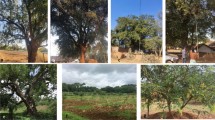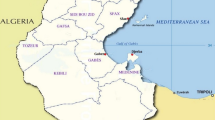Abstract
Random amplified polymorphic DNA markers were used to assess the genetic diversity within and among seven Tunisian diploid and polyploid populations of Teucrium polium L. from five bioclimatic areas. Out of the 141 bands generated from eight selected primers, 124 were polymorphic. The genetic diversity within a population (Shannon’s index) was high and varied according both the ploidal levels and bioclimatic zones. The genetic differentiation among populations assessed by G ST and ΦST statistics was high, suggesting a low level of gene flow among them. The major proportion of the variation was attributable to individual differences within populations. The UPGMA analysis based on Nei and Li’s coefficient showed that individuals from each population clustered together. In a dendrogram using the ΦST distance matrix, population grouping is concordant with bioclimates and cytotypes. Conservation strategies should take into account the level of the genetic diversity of the populations according to their bioclimate and ploidal levels.


Similar content being viewed by others
References
Aburjai T, Hudaib M, Carvini V (2006) Composition of essential oil from Jordanian Germander (Teucrium polium L.). J Essent Oil Res 18(1):97–99
Adams RP (2000) Systematics of Juniperus section Juniperus based on leaf essential oils and RAPD DNA fingerprinting. Biochem Syst Ecol 28:515–528
Barrett SCH, Kohn J (1991) The genetic and evolutionary consequences of small population size in plant: implications for conservation. In: Falk D, Holsinger KE (eds) Genetics and conservation of rare plants. Oxford University Press, Oxford, pp 3–30
Bonnet E, van de Peer Y (2002) ZT: a software tool for simple and partial Mantel tests. J Stat Soft 7(10):1–12
Boulila A (2009) Diversité génétique et variabilité de la composition terpénique des populations naturelles de Teucrium polium L. (Lamiacées) en Tunisie. Phd Thesis, Science Faculty of Tunis
Boulila A, Béjaoui A, Messaoud C, Boussaid M (2008) Variation of volatiles in Tunisian populations of Teucrium polium L. (Lamiaceae). Chem Biodiv 5(7):1389–1400
Bruno M, Maggio AM, Piozzi F, Puech S, Rosselli S, Simmonds MSJ (2003) Neoclerodane diterpenoids from Teucrium polium subsp. polium and their antifeedant activity. Biochem Syst Ecol 31(9):1051–1056
Chizzola R (2006) Volatile compounds from some wild growing aromatic herbs of the Lamiaceae from southern France. Plant Biosyst 40(2):206–210
Couladis M, Tzakou O, Verykokidou E, Harvala C (2003) Screening of some Greek aromatic plants for antioxidant activity. Phytother Res 17(2):194–195
Dagnelie P (1975) Analyse statistique à plusieurs variables. Presses Agronomiques, Gembloux
El Oualidi J, Verneau O, Puech S, Dubuisson JY (1999) Utility of rDNA ITS sequences in the systematics of Teucrium section Polium (Lamiaceae). Plant Syst Evol 215:49–70
El Oualidi J, Puech S, Navarro T (2002) Geographical variation and successive adaptive radiations of yellow-flowered Teucrium (Labiateae) in the Mediterranean region. Bot Rev 68(2):209–234
Ellstrand NC, Elam DR (1993) Population genetic consequences of small population size: implications for plant conservation. Ann Rev Ecol Syst 24:217–242
Emberger L (1966) Une classification biogéographique des climats. Recherches et Travaux des Laboratoires de Géologie, Botanique et Zoologie. Faculté des Sciences Montpellier 7:1–43
Excoffier L, Smouse PE, Quattro JM (1992) Analysis of molecular variance inferred from metric distances among DNA haplotypes: application to human mitochondrial DNA restriction data. Genetics 131:479–491
Fracarro F, Zacaria J, Echeverrigaray S (2005) RAPD based genetic relationships between populations of three chemotypes of Cunila galioides Benth. Biochem Syst Ecol 33:409–417
Grant V (1981) Plant speciation, 2nd edn. Columbia University Press, Irvington
Grundt HH, Popp M, Brochmann C, Oxelman B (2004) Polyploid origins in a circumpolar complex in Draba (Brassicaceae) inferred from cloned nuclear DNA sequences and fingerprints. Mol Phyl Evol 32:695–710
Guldahl AS, Gabrielsen TM, Scheen AC, Borgen L, Steen SW, Spjelkavik S, Brochmann C (2005) The Saxifraga rivularis complex in Svalbard: molecules, ploidy and morphology. Flora 200:207–221
Hamrick JL, Godt MJW (1989) Allozyme diversity in plant species. In: Brown AHD, Clegg MT, Kahler AL, Weir BS (eds) Plant population genetics, breeding and genetic resources. Sinauer, Sunderland, MA, USA, pp 43–63
Hamrick JL, Godt MJW (1996) Effects of life history traits on genetic diversity in plant species. Philo Trans R Soc Lond B 35(1):1291–1298
Hamrick JL, Blanton HM, Hamrick KJ (1989) Genetic structure of geographically marginal populations of ponderosa pine. Am J Bot 76:1559–1568
Hogbin PM, Peakall R (1999) Evaluation of the contribution of genetic research to the management of the endangered plant, Zieria prostrata. Conserv Biol 13:514–522
Holsinger KE, Gottlieb LD (1991) Conservation of rare and endangered plants: principles and prospects. In: Falk DA, Holsinger KE (eds) Genetics and conservation of rare plants. Oxford University Press, New York, pp 195–208
Holsinger KE, Wallace LE (2004) Bayesian approaches for the analysis of population genetic structure: an example from Platanthera leucophaea (Orchidaceae). Mol Ecol 13:887–894
Hudaib M, Mohammad M, Bustanji Y, Tayyem R, Yousef M, Abuirjeie M, Aburjai T (2008) Ethnopharmacological survey of medicinal plants in Jordan, Mujib Nature Reserve and surrounding area. J Ethnopharmacol 120(1):63–71
Husband BC, Schemske DW, Burton TL, Goodwillie C (2002) Pollen competition as a unilateral reproductive barrier between sympatric diploid and tetraploid Chamerion angustifolium. Proc R Soc Lond B 269:2565–2571
Kabouche Z, Boutaghane N, Laggoune S, Kabouche A, Ait-Kaki Z, Benlabed K (2005) Comparative antibacterial activity of five Lamiaceae essential oils from Algeria. Int J Aromather 15(3):129–133
Khanuja SPS, Shasany AK, Pawar A, Lal RK, Darokar MP, Naqvi AA, Rajkumar S, Sundaresan V, Lal N, Kumar S (2005) Essential oil constituents and RAPD markers to establish species relationship in Cymbopogon Spreng. (Poaceae). Biochem Syst Ecol 33:171–186
Konaté I, Filali-Maltouf A, Berraho E-B (2007) Diversity analysis of Moroccan Carob (Ceratonia siliqua L.) accessions using phenotypic traits and RAPD markers. Acta Bot Malacitana 32:79–90
Le Floc’h E (1983) Contribution à une étude ethnobotanique de la flore tunisienne Ministère de l’enseignement supérieur et de la recherche scientifique 2ème partie, Edit. Imp. Off. Rep. Tun., pp 79–80
Lewontin RC (1972) The apportionment of human diversity. Evol Biol 6:381–398
Lodhi MA, Ye GN, Weeden NF, Reisch BI (1994) A simple and efficient method for DNA extraction from grapevine cultivars and Vitis species. Plant Mol Biol Rep 12:6–13
Mahy G, Bruederle LP, Connors B, Van Hofwegen M, Vorsa N (2000) Allozyme evidence for genetic autopolyploidy and high genetic diversity in tetraploid cranberry, Vaccinium oxycoccos (Ericaceae). Am J Bot 87:1882–1889
Mantel N (1967) The detection of disease clustering and a generalized regression approach. Cancer Res 27:209–220
Messaoud C, Afif M, Boulila A, Rejeb MN, Boussaid M (2007) Genetic variation of Tunisian Myrtus communis L. (Myrtaceae) populations assessed by isozymes and RAPDs. Ann For Sci 64:845–853
Navarro T, El Oualidi J (2000) Sinopsis of Teucrium L. (Lamiaceae) in the Mediterranean region and surrounding areas. Flora Med 10:349–363
Nei M, Li WH (1979) Mathematical model for studying genetic variation in terms of restriction endonucleases. Proc Natl Acad Sci USA 76:5269–5273
Newton AC, Allnutt T, Gillies ACM, Lowe AJ, Ennos RA (1999) Molecular phylogeography, intraspecific variation and the conservation of tree species. Trends Ecol Evol 14(4):140–145
Pérez-Collazos E, Catalán P (2006) Palaeopolyploidy, spatial structure and conservation genetics of the narrow steppe plant Vella pseudocytisus subsp. paui (Vellinae, Cruciferae). Ann Bot 97(4):635–647
Puech S (1982) Contribution à l’étude des Teucrium de la section Polium de Tunisie. Bull Soc Bot France (Lett Bot) 129:41–52
Puech S (1985) Contribution à l’étude des Teucrium de la section Polium (Labiatae) de Tunisie (suite). Bull Soc Bot France (Lett Bot) 132:41–50
Puech S (1990) Contribution à l’étude de biosystématique des Teucrium de la section Polium (Labiatae) de Tunisie. Bull Soc Bot France (Lett Bot) 137:63–76
Rohlf FJ (1998) NTSYSpc version 2.0: user guide. Applied Biostatistics Inc., Setauket
SAS (statistical analysis system) (1990) SAS user’s guide: SAS STAT, SAS BASIC. Version 6, 4th edn. SAS Institute Inc., Cary
Solouki M, Mehdikhani H, Zeinali H, Emamjomeh AA (2008) Study of genetic diversity in Chamomile (Matricaria chamomilla) based on morphological traits and molecular markers. Sci Hort 117:281–287
Soltis DE, Soltis PS, Tate JA (2003) Advances in the study of polyploidy since plant speciation. New Phytol 161:173–191
Volis S, Yakubov B, Shulgina I, Ward D, Mendlinger S (2005) Distinguishing adaptive from nonadaptive genetic differentiation: comparison of Q ST and F ST at two spatial scales. Heredity 95:466–475
Wright S (1951) The genetical structure of populations. Ann Eug 15:323–354
Yeh F, Yang R, Boyle T (1999) Popgene, version 1.31. Microsoft window-based freeware for population genetic analysis. University of Alberta, Edmonton
Zheng W, Wang L, Meng L, Liu J (2008) Genetic variation in the endangered Anisodus tanguticus (Solanaceae), an alpine perennial endemic to the Qinghai-Tibetan Plateau. Genetica 132:123–129
Acknowledgments
This research was supported by a grant of the Ministry of Scientific Research and Technology and the National Institute of Applied Science and Technology (Research grant 99/UR/09-10).
Author information
Authors and Affiliations
Corresponding author
Rights and permissions
About this article
Cite this article
Boulila, A., Béjaoui, A., Messaoud, C. et al. Genetic Diversity and Population Structure of Teucrium polium (Lamiaceae) in Tunisia. Biochem Genet 48, 57–70 (2010). https://doi.org/10.1007/s10528-009-9295-6
Received:
Accepted:
Published:
Issue Date:
DOI: https://doi.org/10.1007/s10528-009-9295-6




